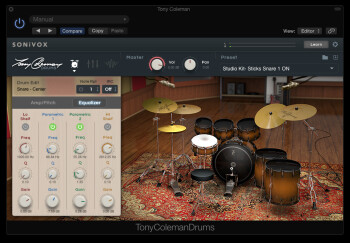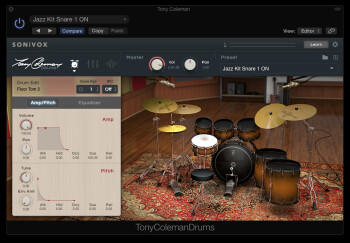SONiVOX's Tony Coleman Drums (Mac/Win), is a virtual drum plug-in featuring sampled kit sounds from Coleman, who’s played with a who’s who of blues and R&B artists including B.B. King, Bobby Blue Bland, Albert King, Albert Collins, Etta James, James Cotton, and Buddy Guy, among others. The sampling session featured Coleman playing his Mapex kit at Ardent Studios in Memphis.
Installation and authorization were easy, with the latter done via a separate authorizer application that appeared on my desktop after installation. The data files for the plug-in are on the hefty side, 20 GB, so you need a lot of free disk space.
The plug-in GUI features a main screen showing an animated version of Coleman’s kit in the studio, setup on an Oriental rug with overhead mics on either side. Clicking on a drum or cymbal auditions it, and when the note sounds the kit piece lights up.
A pull-down kit menu reveals 10 factory kits, each of which comes in two versions. What’s more, each of those versions can be loaded two ways: With the snares on the snare drum turned on or off. That’s a total of 40 different kits, if you do the math.
From what I can gather (although it’s hard to be sure because there’s no documentation included or available for this product), all the kits were recorded from Coleman’s Mapex kit, with Coleman playing. The differences come from playing style, EQ, effects and other parameter settings. If you tweak and save your own kits, they will show up in the pull down in a folder marked User.
Loading a kit can take as little as about 5 seconds, or as long as a minute plus. It’s unpredictable, but generally it’s somewhere between.
Tweaks
The sidebar on the left-hand side of the GUI can be switched between three different views: Drum Edit, Mixer, and Effects. You change between them by clicking little icons right above the sidebar.
The Mixer is very simple: It just has sliders for Kick, Snare, Hi-Hat, Toms, OH, and Room (mics). No solo or mute buttons are provided, but having individual control over those kit elements is very useful. The Room slider lets you dial in a lot of natural ambience.
Here’s an example featuring the Studio Kit, which starts with the room mics off, but when it repeats the they’re on.

In the Drum Edit window, clicking a drum or cymbal makes it active so it can be edited individually. Editable parameters include Volume, Pan, Tune and the amount of pitch envelope, which I’ll explain shortly. In addition to adjusting the level of the drum or cymbal with the knob, you also are given an adjustable amplitude envelope, with breakpoints in it that you can drag to change the envelope’s shape. If you wanted to, say, reduce the attack, you could use the envelope controls to do so. I found the breakpoints a little tricky to manipulate, and there’s no way to reset the envelope to the default if you mess it up (without reloading the kit).
The Tune control knob does not have much resolution, so only about 20 percent of its range in either direction from the default of 12 o’clock is usable. After that, the pitch change is too extreme to be musical, and you’re into sound-effects territory.
The pitch can also be impacted with the Pitch Envelope and Envelope amount controls. I thought perhaps that adjusting the envelope itself would change the way the pitch of the drum samples reacted to the velocity of MIDI notes, but I couldn’t really hear much difference. Again, some documentation could have shed more light on the purpose and correct way to use this feature.
The Drum Edit window also has a second tab, which lets you access EQ for the selected kit piece. It features an equalizer comprised of four bands: Lo Shelf, Parametric 1, Parametric 2, and Hi Shelf. All four have Frequency, Gain, and Q controls, and can be individually turned on or off. Having independent 4-band EQ for each kit piece is an awesome feature. Kudos to SONiVOX for that one.
At the top of the Drum Edit window are two additional parameters, both of which are off by default. The first is Note Repeat, which lets you set a rhythmic value, and if you hold down a key on your MIDI keyboard, the drum will repeat endlessly based on what you set. I don’t have a drum pad controller, so I couldn’t test how it responds to a stick hit. What’s cool is that the notes don’t all sound the same as they repeat, you can hear some sort of randomization going on, so you don’t get the dreaded machine gun effect, and that makes it useful for programming rolls.
The second of the two parameters is called IRC, which stands for Intelligent Rhythm Control. According to the product blurb on the website, it’s designed to “correct note timing without sacrificing musicality.” When you click on the little box, you can set a rhythmic value (quarter-note, eighth-note etc.), which results in a delay of that duration between when you strike the key or pad or whatever controller you’re using, and when the note actually sounds. It took me some experimentation to figure out how it worked. Interestingly, I tried it on the snare drum while recording, and even though I heard the snare sounding late, the MIDI notes were recorded with no delay. To me, the effect is disconcerting, as it’s essentially adding latency. I don’t see what this might be useful for, but again, without any information about it, it’s hard to know.
Feel the effects
The Effects window offers the aforementioned global EQ, which has the same architecture as the individual drum/cymbal EQs. You also get two other global effects: Compressor and Reverb.
The former offers a lot of adjustability, with controls for Input, Attack, Release, Threshold, Ratio, Knee, Output and Wet/Dry level. Having the Wet/Dry control means you can dial in parallel compression just by turning it down below 100 percent wet. Overall, I liked the sound of the Compressor quite a bit.
Here’s a passage first uncompressed and then compressed.

The Reverb also sounds good, and offers a wide range of room sizes and decay times. Overall, the effects section is one of the more impressive parts of this instrument. My only complaint is that the Compressor and Reverb are global, and can’t be accessed from individual drums. I prefer not to send compression to cymbals, nor reverb to kick drums, in most cases, but you have no choice with the architecture of the effects section.
In the groove?
Now that we’ve covered what’s included, let’s talk about what’s missing, namely, Coleman’s playing. The way this product is marketed, it implied to me that it would include MIDI grooves played by Coleman, but that’s not the case.
What made me think that? It was partly from the audio file linked to on the SONiVOX website, and labeled Tony Coleman Drums Demo. There’s also this marketing copy from the website: “The sound and feel of Tony’s illustrious drumming was expertly captured at the lauded Ardent Studios in Memphis, TN, on the best recording gear available.”
Now the sound part I get, but the feel part, not so much. Yes, it’s true that the way each drummer hits is unique, and I’m sure that’s captured here. But it hardly means if I’m tapping out a drum part on my keyboard that I’m going to sound like Tony Coleman. That’s where I expected that MIDI files would come into play. So yes, you get his sound, but not so much his feel.
Lost without a map
Since there are no grooves, you’ve either got to program or play the parts yourself with a controller or MIDI kit, or get some MIDI files somewhere else to use. I tried importing in some commercial GM-mapped MIDI drum grooves that I have, and the mapping didn’t match up. I asked the Sonivox folks about this, and there answer was that it wasn’t GM, but that it was similar to the mapping used by such products as Superior Drummer, Steven Slate Drums and Addictive Drums. I just so happened to have the aforementioned MIDI grooves in multiple formats, so I tried Superior and Slate mappings, and once again, there were some inconsistencies with the Coleman kits.
There is a workaround, which is to use the plug-in’s Learn function to change the mapping. Again, lacking a manual, I had to figure it out by trial and error. I eventually discovered that you have to first press the Learn button, then hit the drum or cymbal whose mapping you want to change in the plug-in’s animated drum kit display, and then hit the key on your controller that you want to change it to. You can save these mappings for future use.
Sound of Tony
So let’s talk about the sounds. SONiVOX clearly took a lot of care with the recording of these samples, even tracking many to 2” tape to get tape compression, before transferring them to digital. The sounds are rich, fat, and realistic. I’m sure they’d sound great in a mix, especially for blues, rock, and (old-style) R&B. I love that a couple of brush kits are included, as is a kit Coleman played with HotRods (similar to Multi Rods or Blastix) and then you get the snare on/off choice with each kit, too.
This example, featuring the Jazz Kit, will give you an idea of the high quality and realism of the drum samples.

Cool, man?
If you haven’t noticed, I have some issues with Tony Coleman Drums ($149). Many of them stem from the lack of documentation, which seems to be a growing problem in the music software world. My message to SONiVOX would be, if you’re going to include non-intuitive functions and features, you need to tell your customers what they are and how to use them. Nobody wants to pay for a product and then have to spend a lot of time trying to figure out features that could be easily and quickly explained with a manual or even just a quick-start guide
It’s too bad, because the drum sounds are very good, and nicely recorded. In fact, I would have given it an even lower rating had it not been for its quality sounds. Perhaps an updated version will include documentation, and hopefully SONiVOX will make it clearer in their marketing that it’s a sound source only, and there’s no Tony Coleman grooves included.
With those changes, Tony Coleman Drums could be a very cool product.



